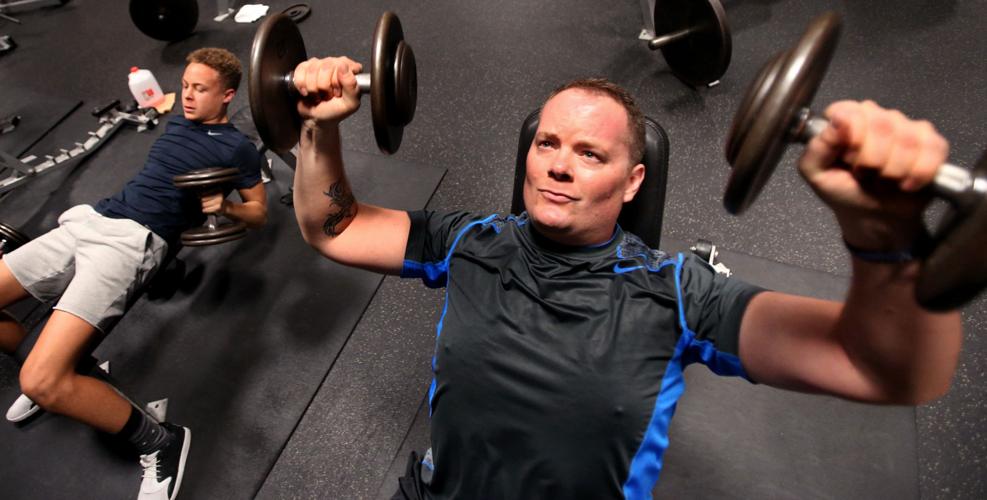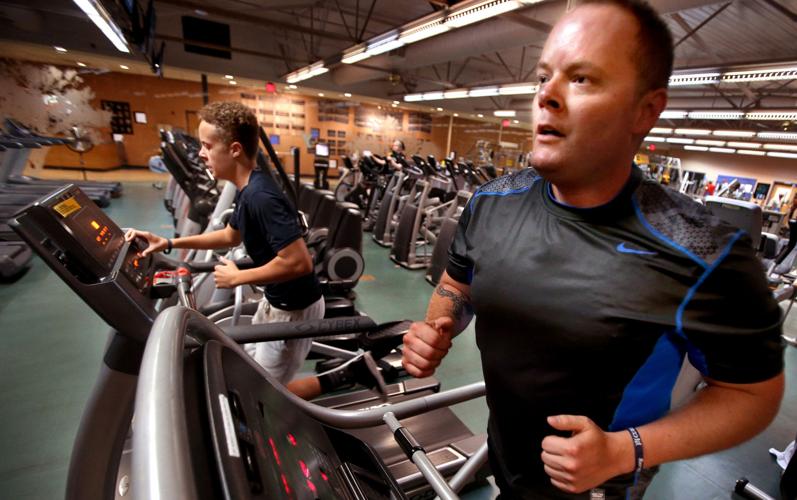When he was diagnosed with a rare muscular disease at the age of 35, Dennis Bracety was convinced his firefighting career was over.
The 6-foot-1-inch Tucson resident spent months feeling sorry for himself, repeatedly asking an unanswerable question: “Why me?”
That mindset is a long way from where he is today — eager to educate others about living with dermatomyositis, a disease that affects about 20,000 Americans and nearly took Bracety's life.
On Saturday, Bracety, now 40, will walk nearly three miles in the Muscular Dystrophy Association’s annual Muscle Walk of Tucson. He’ll walk alongside his 16-year-old son, Drew Bracety, who is a junior at Canyon del Oro High School.
Bracety credits Drew and daughter Ashley Bracety, 23, with providing both the caregiving and tough love he needed to get well.
“It’s because of these guys I’m here,” Bracety said last week, seated in his living room alongside his two children.
“My dad always says there’s no ‘I’ in team,” chimed in Ashley, who works as a medical assistant at the Tucson Orthopaedic Institute.
Tired and swollen
Bracety fell ill in 2011, when he was 10 years into his career with the Rural/Metro Fire Department. At first he ignored the fatigue, weakness and sore muscles. Over a period of about two months, he felt increasingly worse.
“It felt like I was carrying a person on my shoulders,” he said. “I’m a stubborn firefighter. I’d put it off.”
Then he started to swell up. His kids say he looked like a balloon. That’s how he ended up in the office of Tucson neurologist Dr. Lawrence Z. Stern, who is director of the Mucio F. Delgado Clinic for Neuromuscular Disorders at Banner — University Medical Center Tucson.
Stern says his clinic sees four to six Tucson residents per year with dermatomyositis, which is an inflammatory disorder of the muscles and skin. Its cause is not known, but it is generally considered an autoimmune disease.
For many reasons, Bracety didn’t fit the usual patient demographic.
Dermatomyositis is more common in females than males. In adults, the onset is typically around the age of 50, and in children it occurs most often before puberty.
Stern likens the disease to the body becoming allergic to its own muscle and skin. It is fatal in about 5 percent of all cases. If someone dies from dermatomyositis, it is usually because of severe complications, most commonly in the lungs, he said.
Dermatomyositis and the related disease of polymyositis were blamed for the death of 29-year-old National Football League player Ricky Bell in 1984. Bell, who was from Southern California, played for the Tampa Bay Buccaneers and his life story was the subject of a 1991 television movie.
More recently, dermatomyositis caused the death of a University of Arkansas sophomore, media reports say.
Hopeless
For about a year after he was diagnosed, Bracety seemed to be on a steady decline. He spent two months in the hospital. He couldn’t dress himself, feed himself or brush his own teeth. It was a severe case, his doctor said.
“We almost lost Dennis. I was really worried,” Stern said. “We had him in the intensive care unit. He couldn’t swallow on his own and was having trouble breathing. And he wasn’t responding the way I wanted to the prednisone, and the azathioprine, and the whole deal. We gave him intravenous steroids, too, and started him on IVIG (intravenous Immunoglobulin).”
Bracety lost 50 pounds, needed a wheelchair to get around and required a feeding tube to eat. The disease caused an angry and unsightly purplish rash that covered his face and knuckles, which made him avoid all mirrors. Once he was home from the hospital, he never wanted to go out in public.
He would spend days sitting in a recliner in the family living room. He felt hopeless, and it was a stressful time for everyone. His kids remember him saying his career was over.
Then his marriage ended.
“There was a fear of the unknown,” Bracety said. “It was scary.”
Drew and Ashley remained loyal to both parents and stepped into the role of caregivers for their dad. Their mom had been doing most of the heavy lifting until that point, they said. Other family members, neighbors and firefighters also helped.
Drew and Ashley monitored their father’s diet and chastised him for eating junk food and salt, which aggravated his illness. They called Stern if they thought their dad wasn’t following doctor’s orders.
“He once went to Circle K at 3 a.m. and bought chocolate milk and donuts,” Ashley said wryly.
She knew her dad liked high-sodium Chinese dishes and other salty foods, so she watched him like a hawk. As a result of her vigilance, Bracety got used to putting salt-free balsamic vinaigrette on his food.
‘Fire Within’
Drew and Ashley noticed that the more they forced their dad to do things by himself, the more he did.
“He had to learn how to walk, talk, do everything all over again,” Ashley said. “He couldn’t even touch his nose with his hand.”
The recovery was laborious. It would take Bracety more than an hour to eat a meal because of the difficulties he had swallowing.
Yet doing more for himself yielded small improvements, and that’s when Bracety decided he was going to stop feeling sorry for himself. That is also when he started to get better.
He hit the gym and began working out a few times per week. By June of 2013, he was back at work as a firefighter.
He now works out six to eight times per week, usually at the YMCA with Drew or at the fire station with fellow Rural/Metro firefighters. He credits exercise with keeping his disease at bay.
“Most people are able to return to work, but it’s usually not working as a firefighter,” Stern said.
“Usually it’s a desk job, because most people have some residual weakness, they have difficulty climbing stairs, getting up from a low chair, lifting things above their head, that kind of thing. Dennis’ situation is very unusual. I’ve never seen that myself ever before.”
Bracety self-published a book about his condition, “Fire Within: A Memoir of a Firefighter’s Will to Live,” which came out in 2015. Earlier this month he spoke on a panel in New Orleans at the 2016 Patient Conference for the national Myositis Association.
“He just is so strong that he pulled out of it,” Stern said. “Now, you can’t keep him down.”
Bracety is still not in the free and clear when it comes to his health. He continues to take medication for the dermatomyositis, as well as for hypothyroidism, from which he also suffers. He continues to see Stern and every four months gets IVIG treatments.
“He’s doing what he’s doing amazingly, but he’s still requiring pretty significant treatment,” Stern said. “We’re trying to taper him off his medications and so far so good, but in some cases, they’ll need to stay on some dosage of prednisone indefinitely, which has its own side effects.”
Inspired by their dad, Drew wants to have a career in the medical field and Ashley has a long-term goal of becoming a nurse.
Bracety remains optimistic and provides encouragement to other people diagnosed with dermatomyositis, which gets research and advocacy support from the Muscular Dystrophy Association.
“I still have the disease,” he said. “But the disease does not have me.”






